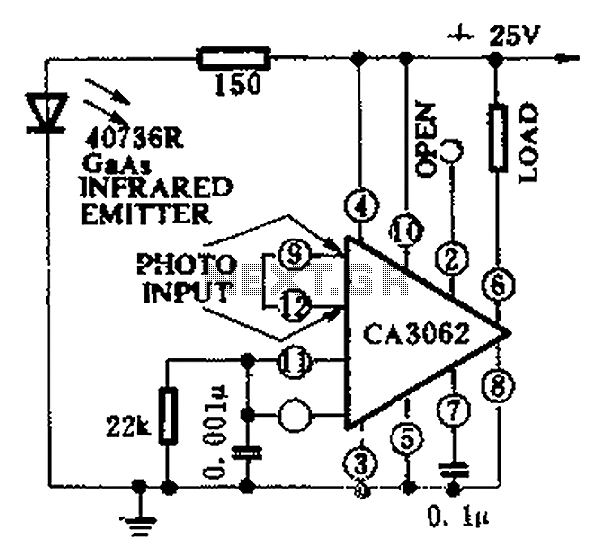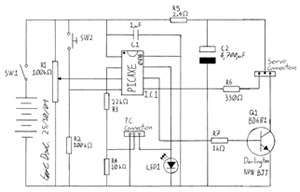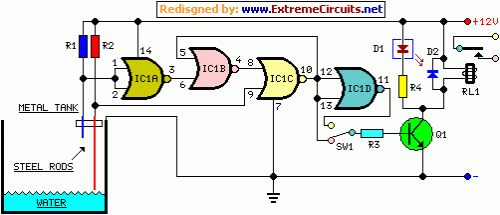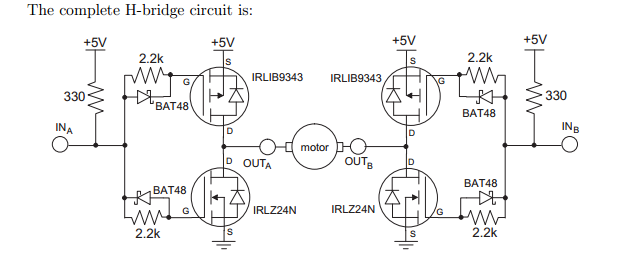
On-off control circuit diagram

CA3062 is a combined photodetector and power amplifier that responds to the optical signal generated by the on/off output. The integrated circuit's transistor output saturation should be either on or off to prevent temperature rise in the silicon. When infrared light-emitting diodes illuminate the light input terminal of the integrated circuit, a complementary output can often be selected through a normally-off or load configuration. The load conditions change when the light path is blocked.
The CA3062 integrated circuit serves as a versatile component in optical sensing applications, combining photodetection and amplification functionalities. The device is designed to detect infrared light signals, making it suitable for various applications such as remote controls, optical communication systems, and safety sensors.
The core functionality of the CA3062 relies on its photodetector, which converts incoming infrared light into an electrical signal. This signal is then amplified by the integrated power amplifier, ensuring that even weak optical signals can be effectively processed. The output stage of the circuit is designed to operate in a saturated state, either fully on or fully off, which is critical for maintaining thermal stability and preventing excessive heat generation within the silicon substrate.
The configuration of the CA3062 allows for flexibility in output selection. When the device is illuminated by infrared light-emitting diodes (LEDs), the output can be configured to operate in a complementary mode, where the output signal is inverted relative to the input. This feature is particularly useful in applications requiring signal inversion or inverting logic levels.
In terms of load management, the CA3062 can be configured with either a normally-off or load setup. The normally-off configuration ensures that the output remains inactive until an infrared signal is detected, providing a fail-safe mechanism in scenarios where the optical path may be obstructed. When the light path is blocked, the circuit's behavior changes, allowing for the management of load conditions and ensuring that the output remains stable.
Overall, the CA3062 integrated circuit is a robust solution for applications requiring reliable optical signal processing, with built-in protections against thermal issues and flexible output configurations to meet diverse system requirements. CA3062 combined photodetectors and power amplifier in response to the optical signal generated by the on/off output. Integrated circuit transistor output saturation should be o n or off, to avoid temperature rise in silicon. When light shines infrared light-emitting diodes to light input terminal of the integrated circuit, often complementary output can be selected through a normally-off or load. The opposite load conditions after blocking the light path.
The CA3062 integrated circuit serves as a versatile component in optical sensing applications, combining photodetection and amplification functionalities. The device is designed to detect infrared light signals, making it suitable for various applications such as remote controls, optical communication systems, and safety sensors.
The core functionality of the CA3062 relies on its photodetector, which converts incoming infrared light into an electrical signal. This signal is then amplified by the integrated power amplifier, ensuring that even weak optical signals can be effectively processed. The output stage of the circuit is designed to operate in a saturated state, either fully on or fully off, which is critical for maintaining thermal stability and preventing excessive heat generation within the silicon substrate.
The configuration of the CA3062 allows for flexibility in output selection. When the device is illuminated by infrared light-emitting diodes (LEDs), the output can be configured to operate in a complementary mode, where the output signal is inverted relative to the input. This feature is particularly useful in applications requiring signal inversion or inverting logic levels.
In terms of load management, the CA3062 can be configured with either a normally-off or load setup. The normally-off configuration ensures that the output remains inactive until an infrared signal is detected, providing a fail-safe mechanism in scenarios where the optical path may be obstructed. When the light path is blocked, the circuit's behavior changes, allowing for the management of load conditions and ensuring that the output remains stable.
Overall, the CA3062 integrated circuit is a robust solution for applications requiring reliable optical signal processing, with built-in protections against thermal issues and flexible output configurations to meet diverse system requirements. CA3062 combined photodetectors and power amplifier in response to the optical signal generated by the on/off output. Integrated circuit transistor output saturation should be o n or off, to avoid temperature rise in silicon. When light shines infrared light-emitting diodes to light input terminal of the integrated circuit, often complementary output can be selected through a normally-off or load. The opposite load conditions after blocking the light path.





